cooling SKODA FABIA 2010 2.G / 5J Owner's Manual
[x] Cancel search | Manufacturer: SKODA, Model Year: 2010, Model line: FABIA, Model: SKODA FABIA 2010 2.G / 5JPages: 244, PDF Size: 29.53 MB
Page 5 of 244
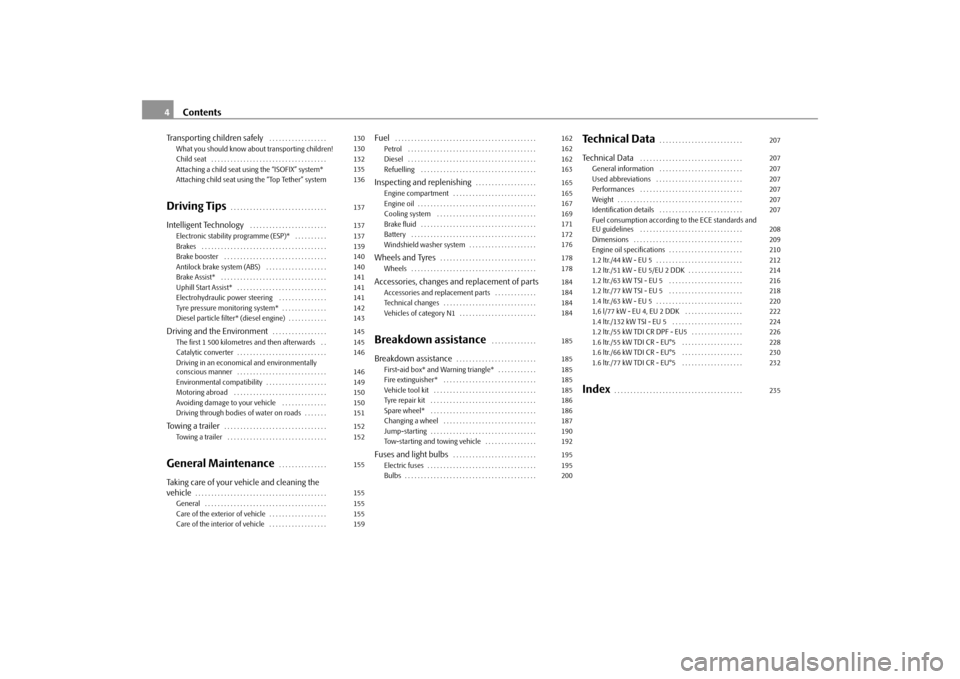
Contents 4
Transporting children safely
. . . . . . . . . . . . . . . . . .
What you should know about transporting children!
Child seat . . . . . . . . . . . . . . . . . . . . . . . . . . . . . . . . . . . .
Attaching a child seat using the “ISOFIX” system*
Attaching child seat using the “Top Tether” system
Driving Tips
. . . . . . . . . . . . . . . . . . . . . . . . . . . . . .
Intelligent Technology
. . . . . . . . . . . . . . . . . . . . . . . .
Electronic stability programme (ESP)* . . . . . . . . . .
Brakes . . . . . . . . . . . . . . . . . . . . . . . . . . . . . . . . . . . . . . .
Brake booster . . . . . . . . . . . . . . . . . . . . . . . . . . . . . . . .
Antilock brake system (ABS) . . . . . . . . . . . . . . . . . . .
Brake Assist* . . . . . . . . . . . . . . . . . . . . . . . . . . . . . . . . .
Uphill Start Assist* . . . . . . . . . . . . . . . . . . . . . . . . . . . .
Electrohydraulic power steering . . . . . . . . . . . . . . .
Tyre pressure monitoring system* . . . . . . . . . . . . . .
Diesel particle filter* (diesel engine) . . . . . . . . . . . .
Driving and the Environment
. . . . . . . . . . . . . . . . .
The first 1 500 kilometres and then afterwards . .
Catalytic converter . . . . . . . . . . . . . . . . . . . . . . . . . . . .
Driving in an economical and environmentally
conscious manner . . . . . . . . . . . . . . . . . . . . . . . . . . . .
Environmental compatibility . . . . . . . . . . . . . . . . . . .
Motoring abroad . . . . . . . . . . . . . . . . . . . . . . . . . . . . .
Avoiding damage to your vehicle . . . . . . . . . . . . . .
Driving through bodies of water on roads . . . . . . .
Towing a trailer
. . . . . . . . . . . . . . . . . . . . . . . . . . . . . . . .
Towing a trailer . . . . . . . . . . . . . . . . . . . . . . . . . . . . . . .
General Maintenance
. . . . . . . . . . . . . . .
Taking care of your vehicle and cleaning the
vehicle
. . . . . . . . . . . . . . . . . . . . . . . . . . . . . . . . . . . . . . . . .
General . . . . . . . . . . . . . . . . . . . . . . . . . . . . . . . . . . . . . .
Care of the exterior of vehicle . . . . . . . . . . . . . . . . . .
Care of the interior of vehicle . . . . . . . . . . . . . . . . . .
Fuel
. . . . . . . . . . . . . . . . . . . . . . . . . . . . . . . . . . . . . . . . . . . .
Petrol . . . . . . . . . . . . . . . . . . . . . . . . . . . . . . . . . . . . . . . .
Diesel . . . . . . . . . . . . . . . . . . . . . . . . . . . . . . . . . . . . . . . .
Refuelling . . . . . . . . . . . . . . . . . . . . . . . . . . . . . . . . . . . .
Inspecting and replenishing
. . . . . . . . . . . . . . . . . . .
Engine compartment . . . . . . . . . . . . . . . . . . . . . . . . . .
Engine oil . . . . . . . . . . . . . . . . . . . . . . . . . . . . . . . . . . . . .
Cooling system . . . . . . . . . . . . . . . . . . . . . . . . . . . . . . .
Brake fluid . . . . . . . . . . . . . . . . . . . . . . . . . . . . . . . . . . . .
Battery . . . . . . . . . . . . . . . . . . . . . . . . . . . . . . . . . . . . . . .
Windshield washer system . . . . . . . . . . . . . . . . . . . . .
Wheels and Tyres
. . . . . . . . . . . . . . . . . . . . . . . . . . . . . .
Wheels . . . . . . . . . . . . . . . . . . . . . . . . . . . . . . . . . . . . . . .
Accessories, changes and replacement of partsAccessories and replacement parts . . . . . . . . . . . . .
Technical changes . . . . . . . . . . . . . . . . . . . . . . . . . . . . .
Vehicles of category N1 . . . . . . . . . . . . . . . . . . . . . . . .Breakdown assistance
. . . . . . . . . . . . . .
Breakdown assistance
. . . . . . . . . . . . . . . . . . . . . . . . .
First-aid box* and Warning triangle* . . . . . . . . . . . .
Fire extinguisher* . . . . . . . . . . . . . . . . . . . . . . . . . . . . .
Vehicle tool kit . . . . . . . . . . . . . . . . . . . . . . . . . . . . . . . .
Tyre repair kit . . . . . . . . . . . . . . . . . . . . . . . . . . . . . . . . .
Spare wheel* . . . . . . . . . . . . . . . . . . . . . . . . . . . . . . . . .
Changing a wheel . . . . . . . . . . . . . . . . . . . . . . . . . . . . .
Jump-starting . . . . . . . . . . . . . . . . . . . . . . . . . . . . . . . . .
Tow-starting and towing vehicle . . . . . . . . . . . . . . . .
Fuses and light bulbs
. . . . . . . . . . . . . . . . . . . . . . . . . .
Electric fuses . . . . . . . . . . . . . . . . . . . . . . . . . . . . . . . . . .
Bulbs . . . . . . . . . . . . . . . . . . . . . . . . . . . . . . . . . . . . . . . . .
Technical Data
. . . . . . . . . . . . . . . . . . . . . . . . . .
Technical Data
. . . . . . . . . . . . . . . . . . . . . . . . . . . . . . . .
General information . . . . . . . . . . . . . . . . . . . . . . . . . .
Used abbreviations . . . . . . . . . . . . . . . . . . . . . . . . . . .
Performances . . . . . . . . . . . . . . . . . . . . . . . . . . . . . . . .
Weight . . . . . . . . . . . . . . . . . . . . . . . . . . . . . . . . . . . . . . .
Identification details . . . . . . . . . . . . . . . . . . . . . . . . . .
Fuel consumption according to the ECE standards and
EU guidelines . . . . . . . . . . . . . . . . . . . . . . . . . . . . . . . .
Dimensions . . . . . . . . . . . . . . . . . . . . . . . . . . . . . . . . . .
Engine oil specifications . . . . . . . . . . . . . . . . . . . . . . .
1.2 ltr./44 kW - EU 5 . . . . . . . . . . . . . . . . . . . . . . . . . . .
1.2 ltr./51 kW - EU 5/EU 2 DDK . . . . . . . . . . . . . . . . .
1.2 ltr./63 kW TSI - EU 5 . . . . . . . . . . . . . . . . . . . . . . .
1.2 ltr./77 kW TSI - EU 5 . . . . . . . . . . . . . . . . . . . . . . .
1.4 ltr./63 kW - EU 5 . . . . . . . . . . . . . . . . . . . . . . . . . . .
1,6 l/77 kW - EU 4, EU 2 DDK . . . . . . . . . . . . . . . . . .
1.4 ltr./132 kW TSI - EU 5 . . . . . . . . . . . . . . . . . . . . . .
1.2 ltr./55 kW TDI CR DPF - EU5 . . . . . . . . . . . . . . . .
1.6 ltr./55 kW TDI CR - EU°5 . . . . . . . . . . . . . . . . . . .
1.6 ltr./66 kW TDI CR - EU°5 . . . . . . . . . . . . . . . . . . .
1.6 ltr./77 kW TDI CR - EU°5 . . . . . . . . . . . . . . . . . . .
Index
. . . . . . . . . . . . . . . . . . . . . . . . . . . . . . . . . . . . . . . .
130130132135136137137137139140140141141141142143145145146146149150150151152152155155155155159
162162162163165165167169171172176178178184184184184185185185185185186186187190192195195200
207207207207207207207208209210212214216218220222224226228230232235
s3j8.a.book Page 4 Tuesday, April 20, 2010 1:10 PM
Page 17 of 244
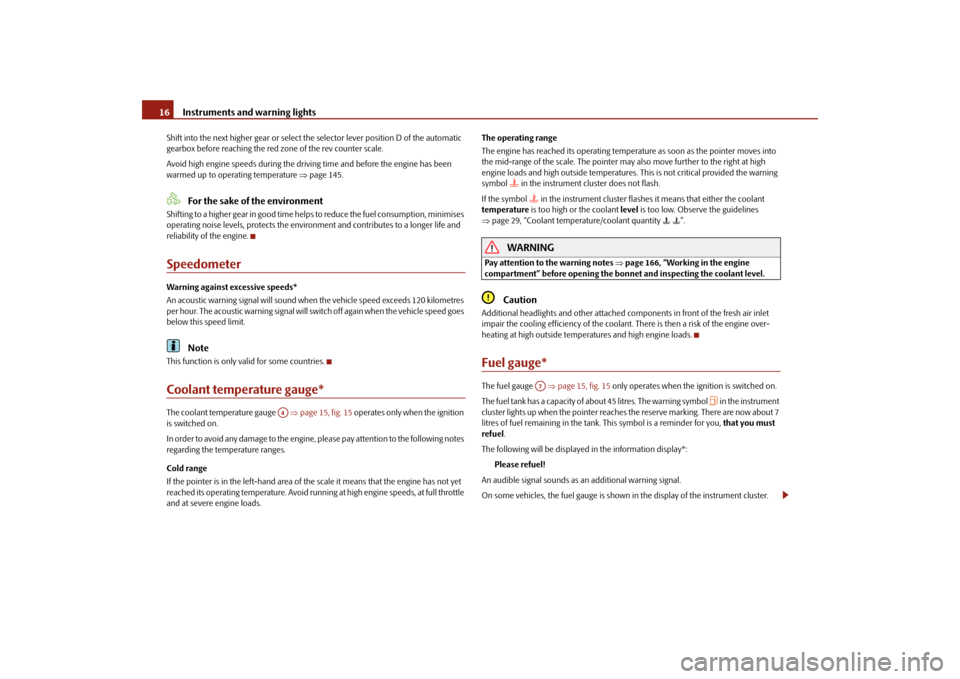
Instruments and warning lights
16Shift into the next higher gear or select th
e selector lever position D of the automatic
gearbox before reaching the red zone of the rev counter scale. Avoid high engine speeds du
ring the driving time and before the engine has been
warmed up to operating temperature
page 145.
For the sake of the environment
Shif ting to a highe r g ear in g ood tim e hel p
s to reduce the fuel
consumption, minimises
operating noise levels, protects the environment and contributes to a longer life and reliability of the engine.SpeedometerWarning against excessive speeds* An acoustic warning signal will sound when
the vehicle speed exceeds 120 kilometres
per hour. The acoustic warning signal will switch off again when the vehicle speed goes below this speed limit.
Note
This function is only
valid for some countries.
Coolant temperature gauge*The coolant temperature gauge
page 15, fig. 15
operates only when the ignition
is switched on. In order to avoid any damage to the engine,
please pay attention to the following notes
regarding the temperature ranges. Cold range If the pointer is in the left-hand area of the scale it means that the engine has not yet reached its operating temperatur
e. Avoid running at high engine speeds, at full throttle
and at severe engine loads.
The operating range The engine has reached its operating temperature as soon as the pointer moves into the mid-range of the scale. The pointer may
also move further to the right at high
engine loads and high outside temperatures. This is not critical provided the warning symbol
in the instrument cl
uster does not flash.
If the symbol
in the instrument cluster flashes it means that either the coolant
temperature
is too high or the coolant
level
is too low. Observe the guidelines
page 29, “Coolant temperature/coolant quantity
”.
WARNING
Pay attention to the warning notes
page 166, “Working in the engine
compartment” before opening the bonn
et and inspecting the coolant level.
Caution
Additional headlights and other attached components in front of the fresh air inlet impair the cooling effi
ciency of the coolant. There is
then a risk of the engine over-
heating at high outside temper
atures and high engine loads.
Fuel gauge*The fuel gauge
page 15, fig. 15
only operates when the ignition is switched on.
The fuel tank has a capacity of
about 45 litres. The warning symbol
in the instrument
cluster lights up when the pointer reaches the reserve marking. There are now about 7 litres of fuel remaining in the tank.
This symbol is a reminder for you,
that you must
refuel
.
The following will be displayed in the information display*:
Please refuel!
An audible signal sounds as an additional warning signal.On some vehicles, the fuel gauge is shown
in the display of the instrument cluster.
A4
A7
s3j8.a.book Page 16 Tuesday, April 20, 2010 1:10 PM
Page 29 of 244
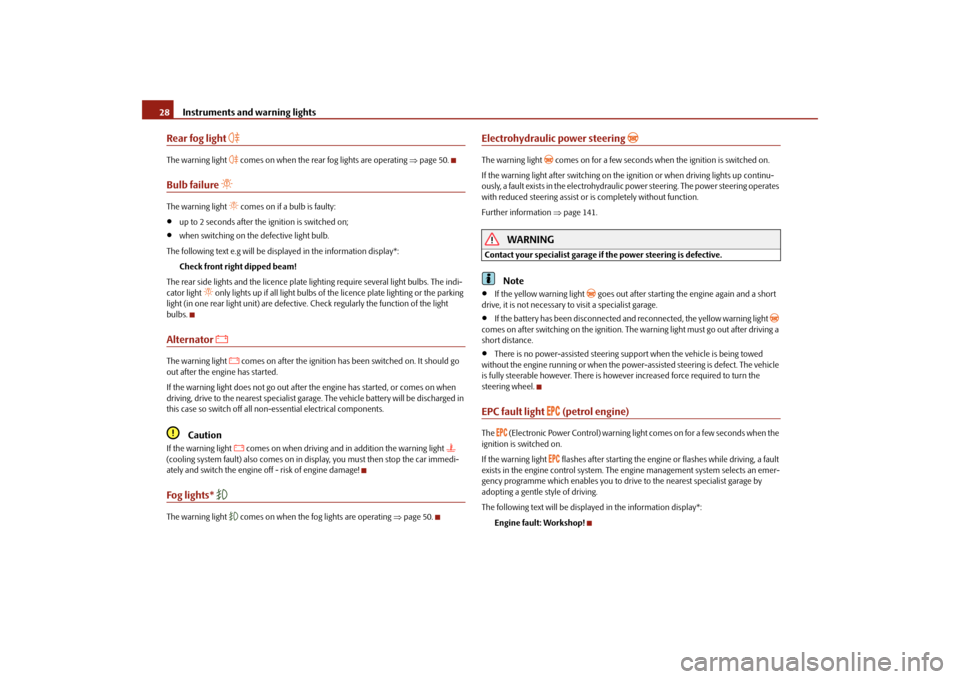
Instruments and warning lights
28Rear fog light
The warning light
comes on when the rear fog lights are operating
page 50.
Bulb failure
The warning light
comes on if a bulb is faulty:
up to 2 seconds after the ignition is switched on;
when switching on the defective light bulb.
The following text e.g will be disp
layed in the information display*:
Check front right dipped beam!
The rear side lights and the licence plate li
ghting require several light bulbs. The indi-
cator light
only lights up if all light bulbs of
the licence plate lighting or the parking
light (in one rear light unit) are defective. Check regularly the function of the light bulbs.Alternator
The warning light
comes on after the ignition has
been switched on. It should go
out after the engine has started. If the warning light does not go out after
the engine has started, or comes on when
driving, drive to the nearest specialist garage. The vehicle battery will be discharged in this case so switch off all non-
essential electrical components.
Caution
If the warning light
comes on when driving and in addition the warning light
(cooling system fault) also comes on in di
splay, you must then stop the car immedi-
ately and switch the engine off - risk of engine damage!Fog lights*
The warning light
comes on when the fog lights are operating
page 50.
Electrohydraulic power steering
The warning light
comes on for a few seconds when the ignition is switched on.
If the warning light after switching on the ignition or when driving lights up continu- ously, a fault exists in the electrohydraulic power steering. The power steering operates with reduced steering assist or is completely without function. Further information
page 141.
WARNING
Contact your specialist
garage if the power steering is defective.
Note
If the yellow warning light
goes out after starting the engine again and a short
drive, it is not necessary to visit a specialist garage.
If the battery has been di
sconnected and reconnected, the yellow warning light
comes on after switching on the ignition. Th
e warning light must go out after driving a
short distance.
There is no power-assisted steering su
pport when the vehicle is being towed
without the engine running or when the power-assisted steering is defect. The vehicle is fully steerable however. There is however increased force required to turn the steering wheel.EPC fault light
(petrol engine)
The
(Electronic Power Control) warning light comes on for a few seconds when the
ignition is switched on. If the warning light
flashes after starting the engine
or flashes while driving, a fault
exists in the engine control system. The en
gine management system selects an emer-
gency programme which enables you to drive to the nearest specialist garage by adopting a gentle style of driving. The following text will be displayed in the information display*:
Engine fault: Workshop!
s3j8.a.book Page 28 Tuesday, April 20, 2010 1:10 PM
Page 30 of 244
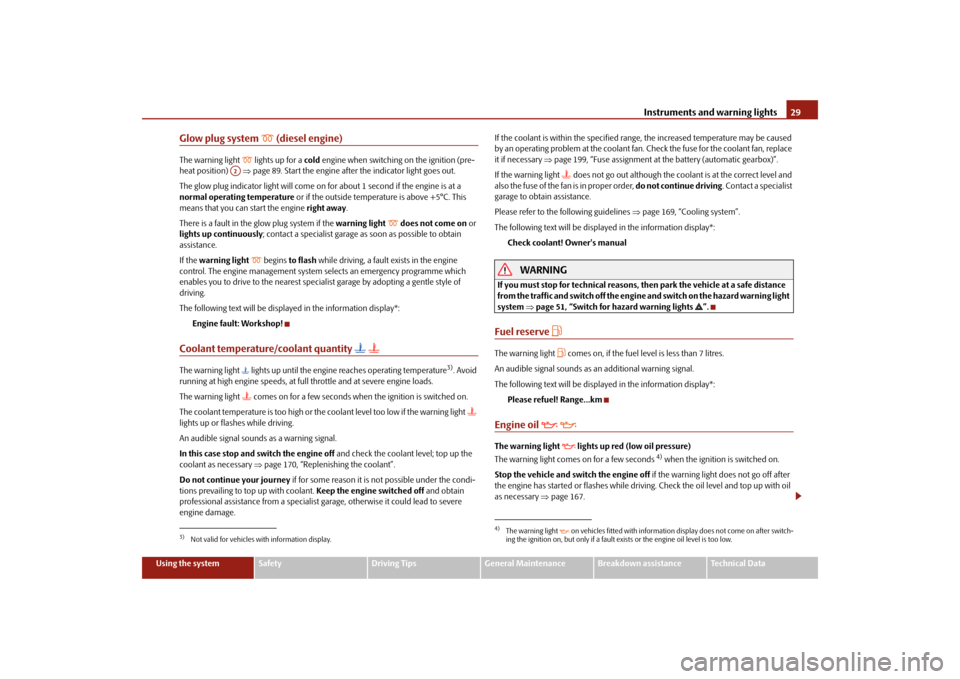
Instruments and warning lights
29
Using the system
Safety
Driving Tips
General Maintenance
Breakdown assistance
Technical Data
Glow plug system
(diesel engine)
The warning light
lights up for a
cold
engine when switching on the ignition (pre-
heat position)
page 89. Start the engine after the indicator light goes out.
The glow plug indicato
r light will come on for about 1
second if the engine is at a
normal operating temperature
or if the outside temperature is above +5°C. This
means that you can start the engine
right away
.
There is a fault in the glow plug system if the
warning light
does not come on
or
lights up continuously
; contact a specialist garage as soon as possible to obtain
assistance. If the
warning light
begins
to flash
while driving, a fault exists in the engine
control. The engine management system
selects an emergency programme which
enables you to drive to the nearest specialist garage by adopting a gentle style of driving. The following text will be displayed in the information display*:
Engine fault: Workshop!
Coolant temperature/coolant quantity
The warning light
lights up until the engine reaches operating temperature
3). Avoid
running at high engine speeds, at full
throttle and at se
vere engine loads.
The warning light
comes on for a few seconds when
the ignition is switched on.
The coolant temperature is too high or the
coolant level too low if the warning light
lights up or flashes while driving. An audible signal sounds as a warning signal.In this case stop and switch the engine off
and check the coolant level; top up the
coolant as necessary
page 170, “Replenishing the coolant”.
Do not continue your journey
if for some reason it is not possible under the condi-
tions prevailing to top up with coolant.
Keep the engine switched off
and obtain
professional assistance from a specialist garage, otherwise it could lead to severe engine damage.
If the coolant is within the specified range, the increased temperature may be caused by an operating problem at the coolant fan.
Check the fuse for the coolant fan, replace
it if necessary
page 199, “Fuse assignment at th
e battery (automatic gearbox)”.
If the warning light
does not go out although the coolant is at the correct level and
also the fuse of the fan is in proper order,
do not continue driving
. Contact a specialist
garage to obtain assistance. Please refer to the following guidelines
page 169, “Cooling system”.
The following text will be displayed in the information display*:
Check coolant! Owner's manual
WARNING
If you must stop for technical reasons, then park the vehicle at a safe distance from the traffic and switch off the engine and switch on the hazard warning light system
page 51, “Switch for hazard warning lights
”.
Fuel reserve
The warning light
comes on, if the fuel level is less than 7 litres.
An audible signal sounds as an additional warning signal.The following text will be displayed in the information display*:
Please refuel! Range...km
Engine oil
The warning light
lights up red (low oil pressure)
The warning light comes on for a few seconds
4) when the ignition is switched on.
Stop the vehicle and switch the engine off
if the warning light does not go off after
the engine has started or flashes while driving. Check the oil level and top up with oil as necessary
page 167.
3)Not valid for vehicles with information display.
A2
4)The warning light
on vehicles fitted with information
display does not come on after switch-
ing the ignition on, but only if a fault exists or the engine oil level is too low.
s3j8.a.book Page 29 Tuesday, April 20, 2010 1:10 PM
Page 77 of 244
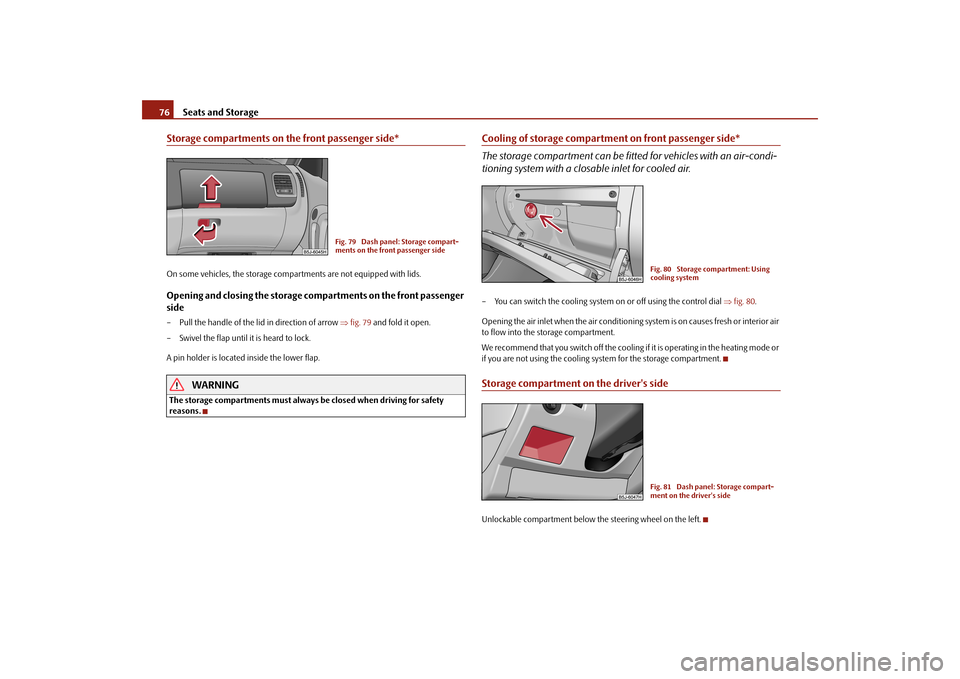
Seats and Storage
76Storage compartments on the front passenger side*On some vehicles, the storage compartments are not equipped with lids.Opening and closing the storage compartments on the front passenger side– Pull the handle of the lid in direction of arrow
fig. 79
and fold it open.
– Swivel the flap until it is heard to lock. A pin holder is located
inside the lower flap.
WARNING
The storage compartments must always be closed when driving for safety reasons.
Cooling of storage compartment on front passenger side* The storage compartment ca
n be fitted for vehicles with an air-condi-
tioning system with a closable inlet for cooled air.– You can switch the cooling system on or off using the control dial
fig. 80
.
Opening the air inlet when the air conditioning system is on causes fresh or interior air to flow into the storage compartment. We recommend that you switch off the cooling if it is operating in the heating mode or if you are not using the cooling system for the storage compartment.Storage compartment on the driver's sideUnlockable compartment below the steering wheel on the left.
Fig. 79 Dash panel: Storage compart- ments on the front passenger side
Fig. 80 Storage compartment: Using cooling system Fig. 81 Dash panel: Storage compart- ment on the driver's side
s3j8.a.book Page 76 Tuesday, April 20, 2010 1:10 PM
Page 84 of 244

Heating and air conditioning system
83
Using the system
Safety
Driving Tips
General Maintenance
Breakdown assistance
Technical Data
Climatic (semi-automatic air conditioning system)*Description Climatic is a combined cooling an
d heating system with electronic
control of the convenience temperature in the vehicle interior. It makes it possible to optimally control the air temperature at any season of the year.Description of the Climatic It is important for your safety and for your
driving comfort that the Climatic is operating
properly. The air conditioning system operates when switch
page 83, fig. 91
is
pressed and the following
conditions are met:
engine running,
outside temperature above +2°C and
blower switch switched on (positions 1 to 4).
If the cooling system is switched on, the temperature and air humidity drops in the vehicle. The wellbeing of the occupants of the
car is enhanced as a result of this partic-
ularly at high outside temperatures and a
high air humidity. The system prevents the
windows misting up during th
e cold season of the year.
The heating effect is dependent upon the c
oolant temperature, thus
full heat output
only occurs when the engine has reached its operating temperature. It is possible to briefly activate recirculat
ed air mode in order to enhance the cooling
effect
.
Air at a temperature of about 5°C may flow
out of the vents under certain circum-
stances when the cooling system is operatin
g. Lengthy and uneven distribution of the
air flow out of the vents (in particular at the leg area) and large differences in temper-ature, for example when getting out of the ve
hicle, can result in chills in sensitive
persons. The air inlet in front of the windscreen must
be free of ice, snow or leaves in order to
ensure that the heating and cooling systems operate properly.
After switching on the cooling
Condensation
from the evaporator of the air condi-
tioning may drip down and form a puddle be
low the vehicle. This is quite normal and
not an indication of a leak!
WARNING
For your own safety and that of other road users, ensure that all the
windows are free of ice, snow and misting. Please familiarize yourself about how to correctly operate
the heating and ventilation systems, how to demist
and defrost the windows, as well as with the cooling mode.
You should not leave recirculated air mode on over a longer period of time,
as “stale” air may result in fatigue in the driver and occupants, divert your attention and also cause the windows to mist up. The risk of having an accident increases. Switch recirculated air mo
de off as soon as the windows begin
misting up.
Note
We recommend that you do not smoke in
the vehicle when the recirculating air
mode is operating since the smoke which is drawn at the evaporator from the interior of the vehicle forms deposits in the evapor
ator of the air conditioning system. This
produces a permanent odour when the Climat
ic is operating which can only be elimi-
nated through considerable effort and
expense (replacement of compressor).
Using the system
AC
AE
Fig. 91 Climatic: Control elements
s3j8.a.book Page 83 Tuesday, April 20, 2010 1:10 PM
Page 85 of 244
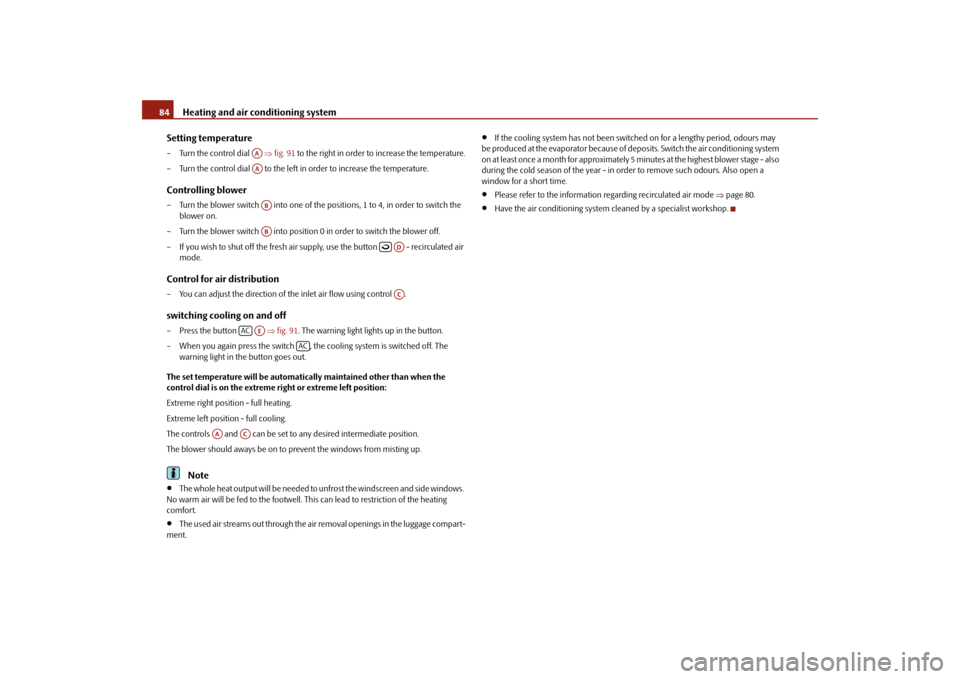
Heating and air conditioning system
84 Setting temperature– Turn the control dial
fig. 91
to the right in order to increase the temperature.
– Turn the control dial to the left in order to increase the temperature.Controlling blower– Turn the blower switch into one of the po
sitions, 1 to 4, in order to switch the
blower on.
– Turn the blower switch into position 0 in order to switch the blower off.– If you wish to shut off the fresh air supp
ly, use the button - recirculated air
mode.
Control for air distribution– You can adjust the direction of the inlet air flow using control .switching cooling on and off– Press the button
fig. 91
. The warning light lights up in the button.
– When you again press the switch , the cooling system is switched off. The
warning light in the button goes out.
The set temperature will be automatically maintained other than when the control dial is on the extreme
right or extreme left position:
Extreme right position - full heating.Extreme left position - full cooling.The controls and can be set to
any desired intermediate position.
The blower should aways be on to prevent the windows from misting up.
Note
The whole heat output will be needed to
unfrost the windscreen and side windows.
No warm air will be fed to the footwell. Th
is can lead to restriction of the heating
comfort.
The used air streams out through the air removal openings in the luggage compart-
ment.
If the cooling system has not been switched on for a lengthy period, odours may
be produced at the evaporator because of de
posits. Switch the air conditioning system
on at least once a month for approximately 5 minutes at the highest blower stage - also during the cold season of the year - in order to remove such odours. Also open a window for a short time.
Please refer to the information regarding recirculated air mode
page 80.
Have the air conditioning system cleaned by a specialist workshop.
AAAAABAB
ADAC
AC
AE
AC
AA
AC
s3j8.a.book Page 84 Tuesday, April 20, 2010 1:10 PM
Page 86 of 244
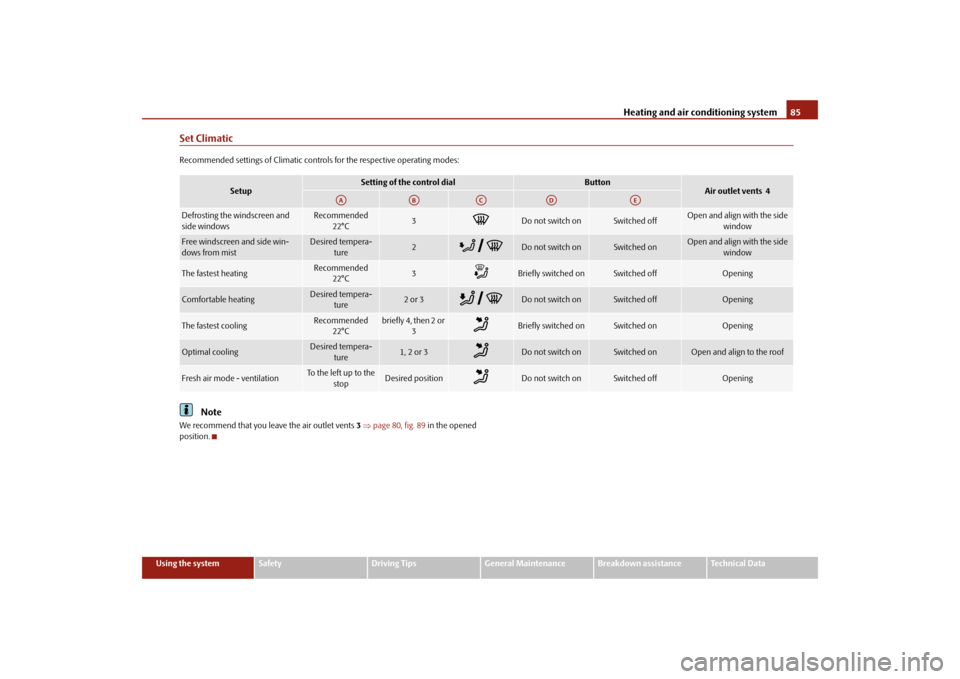
Heating and air conditioning system
85
Using the system
Safety
Driving Tips
General Maintenance
Breakdown assistance
Technical Data
Set ClimaticRecommended settings of Climatic contro
ls for the respective operating modes:
Note
We recommend that you leave the air outlet vents
3 page 80, fig. 89
in the opened
position.
Setup
Setting of the control dial
Button
Air outlet vents 4
Defrosting the windscreen and side windows
Recommended
22°C
3
Do not switch on
Switched off
Open and align with the side
window
Free windscreen and side win- dows from mist
Desired tempera-
ture
2
Do not switch on
Switched on
Open and align with the side
window
The fastest heating
Recommended
22°C
3
Briefly switched on
Switched off
Opening
Comfortable heating
Desired tempera-
ture
2 or 3
Do not switch on
Switched off
Opening
The fastest cooling
Recommended
22°C
briefly4, then 2or
3
Briefly switched on
Switched on
Opening
Optimal cooling
Desired tempera-
ture
1, 2 or 3
Do not switch on
Switched on
Open and align to the roof
Fresh air mode - ventilation
To the left up to the
stop
Desired position
Do not switch on
Switched off
Opening
AA
AB
AC
AD
AE
s3j8.a.book Page 85 Tuesday, April 20, 2010 1:10 PM
Page 87 of 244
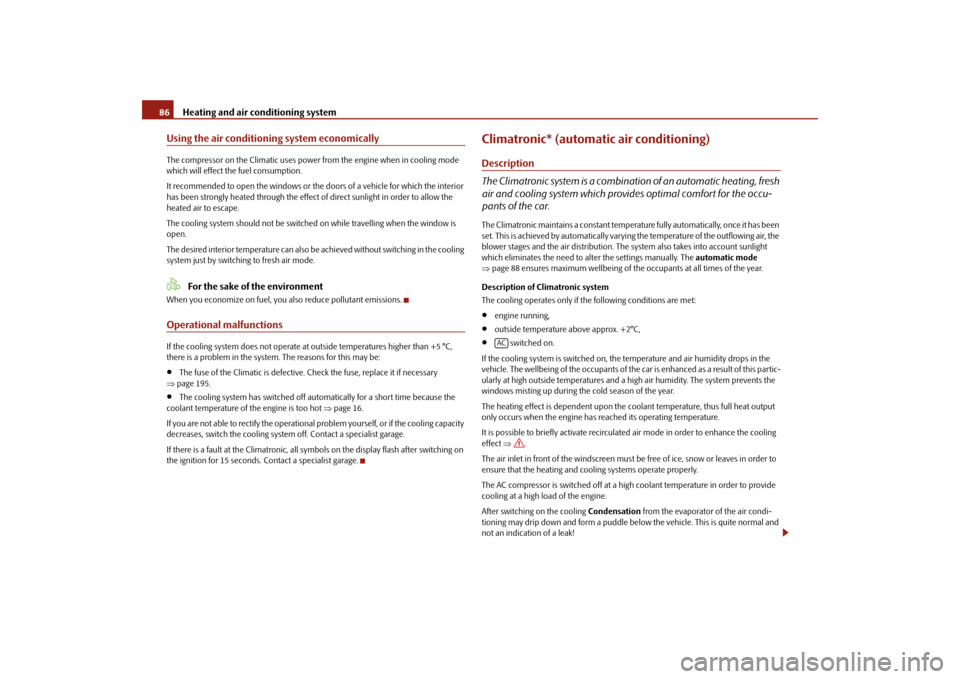
Heating and air conditioning system
86Using the air conditioning system economicallyThe compressor on the Climatic uses powe
r from the engine when in cooling mode
which will effect the fuel consumption. It recommended to open the windows or the
doors of a vehicle for which the interior
has been strongly heated through the effect
of direct sunlight in order to allow the
heated air to escape. The cooling system should not be switched
on while travelling when the window is
open. The desired interior temperature can also be achieved without switching in the cooling system just by switching to fresh air mode.
For the sake of the environment
When you economize on fuel, you also reduce pollutant emissions.Operational malfunctionsIf the cooling system does not operate at outside temperatures higher than +5 °C, there is a problem in the system. The reasons for this may be:
The fuse of the Climatic is defective. Check the fuse, replace it if necessary
page 195.
The cooling system has switched off automatically for a short time because the
coolant temperature of the engine is too hot
page 16.
If you are not able to rectify the operational
problem yourself, or if the cooling capacity
decreases, switch the cooling system off. Contact a specialist garage. If there is a fault at the Climatronic, all symbols on the display flash after switching on the ignition for 15 seconds. Contact a specialist garage.
Climatronic* (automatic air conditioning)Description The Climatronic system is a combinat
ion of an automatic heating, fresh
air and cooling system which provides optimal comfort for the occu- pants of the car.The Climatronic maintains a constant temperat
ure fully automatically, once it has been
set. This is achieved by automatically varying the temperature of the outflowing air, the blower stages and the air distribution. The system also takes into account sunlight which eliminates the need to
alter the settings manually. The
automatic mode
page 88 ensures maximum wellbeing of the
occupants at all times of the year.
Description of Climatronic system The cooling operates only if the following conditions are met:
engine running,
outside temperature above approx. +2°C,
switched on.
If the cooling system is switched on, th
e temperature and air humidity drops in the
vehicle. The wellbeing of the occupants of the car is enhanced as a result of this partic-ularly at high outside temperatures and a high air humidity. The system prevents the windows misting up during the cold season of the year. The heating effect is dependent upon the coolant temperature, thus full heat output only occurs when the engine has reached its operating temperature. It is possible to briefly activate recirculat
ed air mode in order to enhance the cooling
effect
.
The air inlet in front of the windscreen must be free of ice, snow or leaves in order to ensure that the heating and cooling systems operate properly. The AC compressor is switched off at a high
coolant temperature in order to provide
cooling at a high load of the engine. After switching on the cooling
Condensation
from the evaporator of the air condi-
tioning may drip down and form a puddle be
low the vehicle. This is quite normal and
not an indication of a leak!
AC
s3j8.a.book Page 86 Tuesday, April 20, 2010 1:10 PM
Page 88 of 244
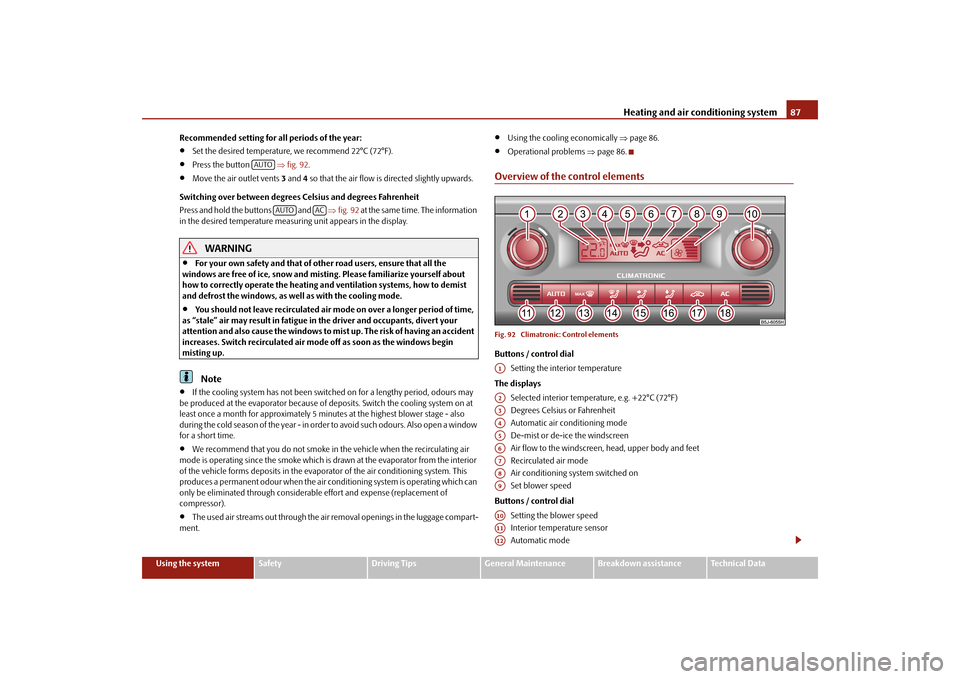
Heating and air conditioning system
87
Using the system
Safety
Driving Tips
General Maintenance
Breakdown assistance
Technical Data
Recommended setting for all periods of the year:
Set the desired temperature, we recommend 22°C (72°F).
Press the button
fig. 92
.
Move the air outlet vents
3 and
4 so that the air flow is
directed slightly upwards.
Switching over between degrees
Celsius and degrees Fahrenheit
Press and hold the buttons and
fig. 92
at the same time. The information
in the desired temperature measuring unit appears in the display.
WARNING
For your own safety and that of other road users, ensure that all the
windows are free of ice, snow and mistin
g. Please familiarize yourself about
how to correctly operate th
e heating and ventilation systems, how to demist
and defrost the windows, as well as with the cooling mode.
You should not leave recirculated air mode on over a longer period of time,
as “stale” air may result in fatigue in the driver and occupants, divert your attention and also cause the windows to mist up. The risk of having an accident increases. Switch recirculated air mode off as soon as the windows begin misting up.
Note
If the cooling system has not been switched on for a lengthy period, odours may
be produced at the evaporator because of
deposits. Switch the cooling system on at
least once a month for approximately 5 minut
es at the highest blower stage - also
during the cold se aso n of the y ear - i n o rde
r to avoid such odours. Also open a window
for a short time.
We recommend that you do not smoke in the vehicle when the recirculating air
mode is operating since the smoke which is drawn at the evaporator from the interior of the vehicle forms deposits in the evapor
ator of the air conditioning system. This
produces a permanent odour when the air co
nditioning system is operating which can
only be eliminated through considerable
effort and expense (replacement of
compressor).
The used air streams out through the air
removal openings in the luggage compart-
ment.
Using the cooling economically
page 86.
Operational problems
page 86.
Overview of the control elementsFig. 92 Climatronic: Control elementsButtons / control dial
Setting the interior temperature
The displays
Selected interior temperature, e.g. +22°C (72°F) Degrees Celsius or FahrenheitAutomatic air conditioning mode De-mist or de-ice the windscreen Air flow to the windscreen, head, upper body and feet Recirculated air mode Air conditioning sy
stem switched on
Set blower speed
Buttons / control dial
Setting the blower speed Interior temperature sensorAutomatic mode
AUTO
AUTO
AC
A1A2A3A4A5A6A7A8A9A10A11A12
s3j8.a.book Page 87 Tuesday, April 20, 2010 1:10 PM